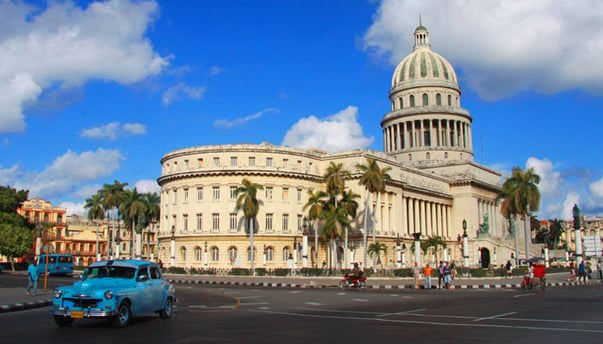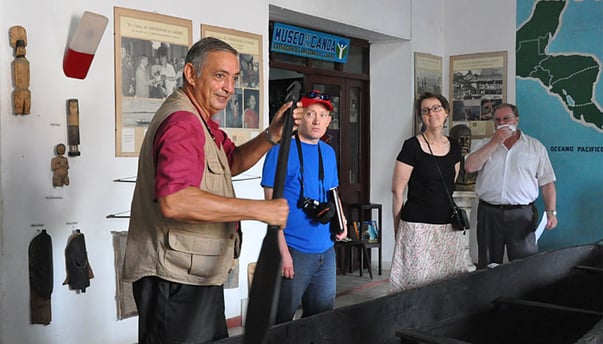What’s Next for Cuba: Airlines pull back, but what about group travel?
Has Cuba lost its luster or not? Cuba has been among the most popular educational travel destinations the last few years. In 2016 Cuba had a record 4 million international tourists, a 13% increase from the prior year, with the greatest increase from US travelers.
But in March — just six months after a major increase in capacity — US airlines reported a startling pullback in flights to Cuba. American Airlines, JetBlue, Frontier, and other airlines have cut flights or switched to smaller aircraft. Silver Airways, which operated direct flights from Fort Lauderdale, pulled out altogether. Plus, some US travel planners report advance bookings have slowed from last year. Could this be a momentary pause or a signal of declining interest?

photo by Guillaume Baviere
In fact, preliminary numbers indicate Cuba arrivals for 2017 are on the rise from the year before. A closer look shows the cutback in airline seats was not for lack of demand but more a result of the gold-rush surge to grab market share. An estimated 300% increase in capacity at one time was not sustainable, cites a Silver Airways representative. And as an American Airlines spokesperson admitted, “We started pretty big in Cuba” and had to cut back due to travel patterns, according to the New York Times.
“There was bound to be a burst from the loosening of diplomatic restrictions in 2014,” states Andrea Holbrook. Holbrook Travel’s group travel programs for 2017 have not seen a decline in group size, and in fact often sell out with waitlists. “Cuba will continue to be a great destination for group travel, even with the easier entry rules for individuals and many airline options. US travelers have only scratched the surface of this fascinating, diverse, and welcoming country.”
Cuba’s experience parallels that of similarly restricted destinations. In recent years China, Vietnam, Eastern Europe, and Russia all witnessed a pent-up demand followed by a removal of travel restrictions, and all have had steady group tourism business since. The continued growth comes from well-thought-out travel itineraries that ordinary travelers cannot get on their own.

photo by Michelle Korczynski
“Sophisticated travelers want a more in-depth, authentic experience,” Andrea says. “You need to provide access to amazing experts; Cuba has tremendous scholars, researchers, naturalists, scientists, and artists. It is vital to expose US travelers to these leaders who can tell the complex Cuban story. Having access to excellent national and local guides who are there to facilitate every aspect of the program — this is something that should not be underestimated. While the charm and warmth of the Cuban experience is guaranteed to any traveler, the understanding and insight about the natural and cultural history is not. For that, you need expert guides and specialists in their fields, and well-planned programs.”
Despite the ease of entry and flights to Cuba, getting around remains a challenge. Ordinary travelers find it tough once they enter to find accommodations and transport options. As with other countries that have experienced change, travelers come to realize the benefits of working with an experienced travel organizer if they want a quality experience.

photo by Julio Larramendi
Natural History and Cuba
While Havana is, in fact, quite impacted by the increase in US travel to Cuba, many areas that are of greatest interest to nature travelers are still relatively unaffected by the tourism that is growing and are free of major development at this time. From the terrestrial Alexander Humboldt National Park in eastern Cuba to the Guanahacabibes National Park in the west, there are many pristine natural areas to explore.
Holbrook has been a pioneer in natural history programming there, offering trips led by Cuban specialists as well as a national guide and local guides. For example, birding programs are accompanied by a Cuban ornithologist throughout, and for botanical and garden programs, a Cuban botanist accompanies travelers along with a natural guide. The same is true for sea turtle and marine conservation; Holbrook has experts within the national park areas that provide additional expertise.
 photo by Guillaume Baviere
photo by Guillaume Baviere
Cuban Contemporary Culture and Society
Afro-Cuban culture and music are also finding popularity among travelers. “Cuba is an exciting and unique place to visit, not [just] because I was born there,” states Dr. Alberto Jones, a group leader and organizer of Cuba travel programs for US travelers. “I have visited so many other places, but there’s something unique to Cuba that binds people once they visit. It’s the people. It’s the history. It’s contagious.” Dr. Jones leads a program, “Cuba: 500 Years of Cuban History and Culture" (see more about Dr. Jones's trip in this video), which follows the theme of Cuba’s indomitable cultural identity defined by resilience, tenacity, and spirit despite isolation and oppression.
Another recent program, “Cuba: The Island of Music, History, and Arts,” sponsored by the Friends of the Ocean City Pops, had a music theme with extra activities not ordinarily available to outsiders. “The experiences were incomparable - so varied and fun!” said traveler Geraldine DiPersia. “We were happy to interact with the locals, talking with them, singing, dancing, playing games - what a fabulous experience, an in-depth view of Cuban life!”
main photo by Guillaume Baviere



